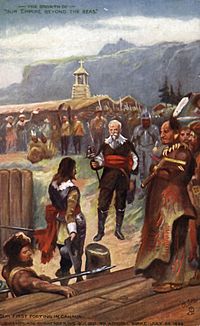Surrender of Quebec facts for kids
Quick facts for kids Surrender of Quebec |
|||||||
|---|---|---|---|---|---|---|---|
| Part of the Anglo-French Wars | |||||||
 Champlain surrendering Quebec to Admiral Kirke, July 20 1629 |
|||||||
|
|||||||
| Belligerents | |||||||
| Commanders and leaders | |||||||
| Samuel de Champlain | David Kirke | ||||||
The surrender of Quebec in 1629 was when the English took control of Quebec City. This happened during the Anglo-French War (1627–1629), a conflict between England and France.
The English, led by David Kirke, took Quebec without a big battle. They did this by stopping the town's supplies. This made it impossible for the French defenders to keep going.
Contents
Why Did the English Attack Quebec?
The story began in 1627. Some merchants in London formed a group called the Company of Adventurers to Canada. Their goal was to make money by trading and setting up settlements along the Saint Lawrence River.
This company was made up of private investors. The King of England, Charles I of England, gave them official permission to expand English influence in new lands. When the Anglo-French War started that same year, the company paid for a trip. King Charles I ordered them to remove the French from "Canida," where they had settlements along the Saint Lawrence River.
David Kirke set off with three ships. His brothers, Lewis, Thomas, John, and James, joined him. They might have sailed with other ships bringing settlers to Charlesfort in Acadia.
The English Campaign
Kirke's group may have stopped at Ferryland in Newfoundland. This was a colony belonging to George Calvert, 1st Baron Baltimore. The Kirke expedition then landed at Port Royal, which they used as their base.
The English force sailed up the Saint Lawrence River. They took over Tadoussac, which is about 160 kilometers north of Quebec. Kirke quickly destroyed the French settlement there. He then did the same at Cap Tourmente.
Blocking Supplies to Quebec
Kirke set up a blockade to stop any French ships bringing supplies into the river for Quebec. He managed to capture a French supply ship.
After this, Kirke sent some Basque fishermen to Samuel de Champlain, the leader of Quebec. They delivered a message demanding that the French give up the fortress town. Champlain refused because he was hoping for help from France. Kirke decided not to attack Quebec directly at that time.
As winter approached, Kirke's ships sailed back towards England. On their way, they met a French supply fleet of four ships. This fleet was led by Admiral Claude Roquemont de Brison. The English captured these French ships after a short fight.
Taking Over Quebec
An English invasion fleet left Gravesend in March 1629. It had six ships and three smaller boats called pinnaces. A French deserter named Jacques Michel went with them to guide them on the St. Lawrence River.
Meanwhile, Quebec's residents were starving. Champlain sent a group from Quebec to meet a relief fleet he was expecting. This fleet was led by Émery de Caën. Champlain did not know that peace had already been declared in Europe in April. This peace was part of the Treaty of Susa.
Champlain's group met de Caën in the Gulf. But on their way upriver to Quebec, the English captured them. Kirke now knew how desperate the situation was in Quebec. He sent his brothers, Lewis and Thomas, to demand that Champlain surrender. Champlain had no other choice. He surrendered Quebec on July 19, 1629.
What Happened After Quebec's Surrender?
After the English took Quebec, Samuel de Champlain of the Company of Adventurers asked the King for special rights. They wanted the sole right to trade and settle in Canada along the St. Lawrence River.
However, Sir William Alexander complained. He said that such a right would interfere with land he had been given in February 1627. The two groups found a way to work together. Alexander would set up an Anglo-Scottish colony at Tadoussac. He would control all the land within ten leagues (about 55 kilometers) on both sides of the river. The Company would have the right to trade freely and use the harbors.
But Champlain argued that the English taking of the lands was against the law. He said the war had already ended when they took Quebec. He worked hard to get the lands back for France.
As part of the peace talks to end the Anglo-French War, King Charles I of England agreed to return the lands. In return, Louis XIII of France would pay his wife's dowry (money or property given by the bride's family). These terms became law with the Treaty of Saint-Germain-en-Laye (1632).
The lands in Quebec and Acadia were given back to the French Company of One Hundred Associates. This company had lost most of its money when the English captured their supply fleet.
The Kirke brothers were born and grew up in France. Because of this, their actions were seen as treason there. When the news of the French defeat reached Paris, a dummy of the Kirke brothers was burned in the city.
In England, the Kirke brothers were honored. They were given a special addition to their family coats of arms in 1631. This addition was based on the coat of arms of the defeated Admiral Roquemont. David Kirke was also made a knight in 1633.
See also
- List of conflicts in Canada

